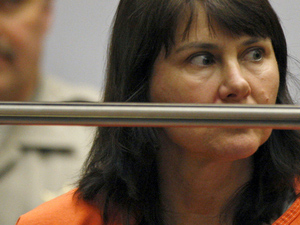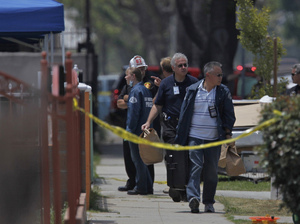On the night of Feb. 24, 1986, John Ruetten came home to discover his 29-year-old bride dead. Sherri Rae Rasmussen had been beaten and shot to death. In the days that followed, homicide detectives in Los Angeles didn't come up with much.

Stephanie Lazarus is arraigned on murder charges at the Criminal Justice Center in Los Angeles on June 9, 2009. The veteran Los Angeles police detective is accused of killing an ex-boyfriend's wife 23 years ago. (Mark Boster/Pool, Los Angeles Times)
"At the time they focused on a theory that two men had tried to break into the victim's house and were in the process of robbing the house when she came home," Los Angeles Times reporter Joel Rubin tells NPR's Audie Cornish. The Los Angeles Police Department chalked the murder up to a botched robbery gone bad. No arrest was made.
More than 20 years later, the LAPD cold case unit reopened the case. "They saw in the file that there was a saliva sample that had been extracted from a bite mark on the victim," says Rubin.
When cold case detectives tested the sample, they learned that the saliva was from a woman, not a man. That blew the original theory from 25 years ago out of the water, he says.
Detectives re-interviewed Rasmussen's husband and family members and were told to look into Stephanie Lazarus, says Rubin. At the time of the murder, Lazarus was a patrol officer in the Los Angeles Police Department. Over time, Lazarus had risen to the rank of detective.
Police say the saliva sample from Rasmussen's bite mark matched Lazarus. Police suspect that the murder was a crime of passion. Lazarus has pleaded not guilty and is awaiting trail, but the case is one of several recently stamped "closed" by the LAPD cold case unit.
DNA: The Arch Nemesis
"The Grim Sleeper" was the nickname given to a Los Angeles serial killer believed to be responsible for nearly a dozen murders starting back in 1985. Police lifted a DNA profile from several of the victims and the crime scenes, but couldn't do much with it.

Police collect evidence during a search at the home of Lonnie David Franklin Jr., the suspected "Grim Sleeper" serial killer, on July 9. Franklin was charged with 10 counts of murder. (Damian Dovarganes/AP)
"At the time of a lot of these unsolved murders, DNA testing had come on the scene but it was still very much in it's infancy," says Rubin.
But even when the cold case unit reopened "The Grim Sleeper" cases and tested the old samples, they came up short.
"When they ran that genetic profile through the databases that they have of convicted felons and now anybody arrested of a felony, it wasn't coming up as matching to anybody that was in the system," Rubin tells Cornish.
But with an advanced DNA process called familial analysis, police were able to come up with a match to a family member - the son of the alleged killer, says Rubin.
"It was a very new process. In fact this case is considered the first real high profile case in which this testing was done in the U.S.," he says.
Lonnie David Franklin Jr. was arrested on July 7 and charged with 10 counts of murder and one count of attempted murder.
No TV Crews Here
When the LAPD cold case unit was created in 2001, the detectives were handed over 9,000 unsolved murders that spanned over two decades.
"During the late '80s and early '90s when the homicide rates in Los Angeles where skyrocketing, they peaked at a time when there was roughly 1,100 or 1,200 killings in the city every year," says Rubin.
Detectives first focused on cases that had genetic material samples, "whether they be blood, or semen or hair or anything that had been collected that with the advent of DNA testing and DNA technology might be able to be solved," he says.
Of the 9,000 unsolved murders the unit inherited, detectives estimate they have reopened about 1,600 and have been able to close or clear more than 100 murders, says Rubin. "That's 100 cases that would have been unsolved had they not started this unit presumably," he says.
With high-profile cases like "The Grim Sleeper" and the Lazarus case, the cold case unit has been a bright spot for the Los Angeles Police Department.
"There certainly is a fascination with the unit. I think there's a lot of respect for these guys and a level of awe with the technology and how it works," Rubin says. There might be a misconception of what actually goes on inside a cold case unit, however.
"It has seeped into our popular cultural. You can't turn on a TV it seems without seeing some show, some dramatization of cold cases," Rubin says. The actual process is not nearly as quick or seamless as television shows would have you believe.
"When they do send something off to the lab and it comes back with a hit ... they then have to retrace all the steps that were taken so many years before and they really do re-investigate these cases from scratch," he says.
As Rubin puts it, for the real-life LAPD cold case unit, DNA hits are not the end, they're just the beginning.











